William Walshaw – a man of many talents?
- Home
- World War I Articles
- William Walshaw – a man of many talents?
Introduction & Pension Cards
The following saga originated from the discovery of a pension card featuring William Walshaw, a man who had evidently served under this name in the Kings Liverpool Regiment, the Manchester Regiment, the Royal Marines Band, and the Royal Navy; but with additional service in the Royal Horse Artillery under the name Alfred Gordon, and with the 6th Dragoons under the name John Thompson.

This man turned out to even more interesting than could possibly have been predicted, and his life has been set out in more or less chronological order, rather than going through the various steps that allowed his profile to be pieced together.
Many of his documents have survived in the burnt series, relating not only to service in the Liverpool and Manchester Regiments, but also in the Middlesex Regiment and Labour Corps. Further extant records relate to service in the Royal Navy and Royal Marines.
No record of service in the Artillery or the Dragoons could be found under the aliases of John Thompson and Alfred Gordon referred to in the pension cards.

While this card suggests he served in the Kings Liverpool Regiment under the name Alfred Gordon, this does not seem to have been the case. As will be seen later, he actually enlisted in this regiment in 1919 under his real name of William Walshaw.



Early Life
William Walshaw was born in Oldham on the 13 May 1886, the son of William Lee Walshaw and Sarah Burnley, who married in Rashcliffe, Huddersfield in 1872.

By 1890 the family had moved to Oldham, and his baptism took place at Oldham St Mary on 30 April 1890, his father recorded as William Lee Walsham, a horsekeeper of Back King Street, Oldham, a status which would be elevated whenever cited by his son William.
The 1891 census shows the family at this address, with his father then recorded as a grocer’s carter.
The family clearly started to unravel in 1897 when his mother Sarah died aged 45 in the third quarter of that year, his brother James had left home to join the army, and his brother Frederick had already joined the Royal Navy. The death of William’s father, aged 52, was registered in Oldham in the first quarter of 1901, leaving William an orphan.
The 1901 census reveals William’s brother Fred to be serving in ‘Royal Oak’ in Malta, while young William was at the industrial school at Lostock, near Bolton, learning to be a tailor. This was actually a Reformatory School for Juvenile Offenders until 1924, suggesting that he was already leading a life of crime. It later became Lostock Open Air School Farm. A report of 1896 indicated 24 boys were learning the tailoring trade. The school was equipped with a swimming pool and gymnasium, had facilities for football and cricket, and had a brass band. Some 30 acres of the site were farmed and according to the report the pig enclosure was rather too close to the buildings for comfort.


William had been baptised for a second time on 30 April 1900, with his date of birth recorded as 13 May 1886, his occupation given as groom, and abode of Industrial School; his father’s name was recorded as William Walshaw. This baptism took place at St John the Evangelist, Wingates, Westhoughton, and the church register shows this was normal practice, probably to encourage the boys to attend church services.
The school found places for its departing inmates, and fortunately William didn’t become a coal miner as so many in the area did.
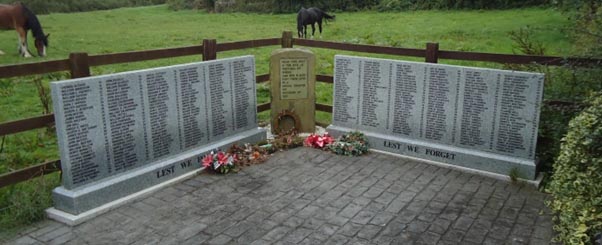
On a lighter note, Westhoughton is known locally as Keaw Yed City, being infamous for an alleged event when locals, known as ‘Owfeners’ or ‘Keaw Yedders’, freed a cow which had become trapped in a five bar gate, by sawing off its head. No offence is meant to folk from Westhoughton, and Holt’s Bitter in the White Lion comes highly recommended.
In the Navy
William almost certainly gained musical experience while at the school, and perhaps also influenced by his elder brother, enlisted in the Royal Navy, as a boy bandsman, on 31 May 1901. His service number 344689 appears on his pension card.
His first ship, HMS Impregnable was a training ship for boys joining the Royal Navy. Many were orphans or had a criminal background.
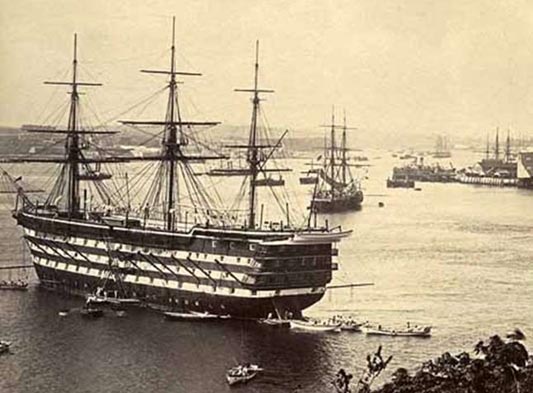
He transferred to the Royal Marines School of Music on 13 May 1902, his character was rated as Very Good, so he was off to a fresh start.

William’s service with the Royal Marines Band, after transfer from the Royal Navy, began on 14 September 1904, as PO 13575, indicating an original enlistment in Portsmouth. His service number was recorded as 611, and appears on his pension card. His next of kin was his brother Fred, living in Gosport and still serving in the Royal Navy.
A second record appears, under Register number 13575, and shows less than satisfactory service. His character was rated only as ‘fair’ and he deserted twice, on the 30 October 1905, and then again on the 6 December, while serving at Exmouth. He was discharged on 19 February 1906 as ‘Objectionable’.
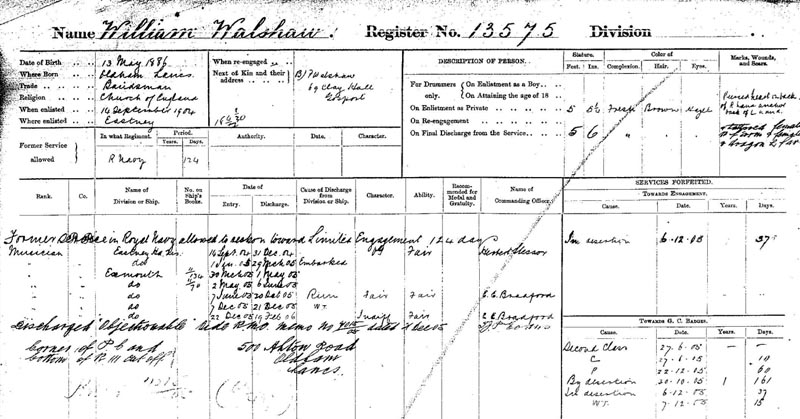
First Recorded Criminal Record
William had unfortunately wasted an opportunity to serve in one of the elite branches of the service and his return to Oldham coincided with a return to crime, as recorded in a later service record when with the army.
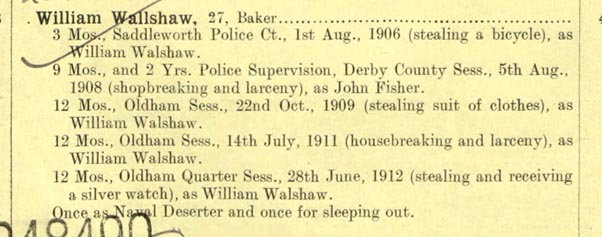
This evidently meant that our man spent over three years in the ‘Strangeways Hotel’ in Manchester, between 1906 and 1913.
Great War Service & Marriage
The Great War gave William another chance, and he somehow managed to re-enlist in the Royal Navy as J44517 on 28 September 1915. His service record notes that he had failed to mention his previous service in the Royal Navy, and which would have linked him to the Royal Marines and a dishonourable discharge.
He was stationed at H.M.S. Victory I, a shore base at Portsmouth, but not for long, being recorded as having ‘run’, in other words deserted, on 5 November 1915.
It was now time to try his luck in the Army, and not wanting to waste any time he promptly enlisted on 18 November as no 5289 in the 4/7th Middlesex Regiment, giving an address in Kentish Town. His attestation form, from the burnt series, also carries the number 57440, which appears on his pension card, with the Manchester Regiment.
William was initially successful in his soldiering career, being promoted corporal on 1 December 1915, and sergeant on 19 February 1916.
William married Lillian Maud Edith Pateman on 17 June 1916 at St Michael-at-Bowes parish Church in Wood Green, and this is also recorded in his service papers.
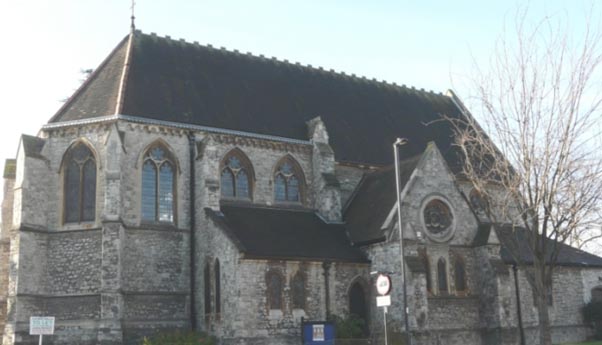
Rather unusually a copy of their marriage bond exists, as well as the entry from the original church register.
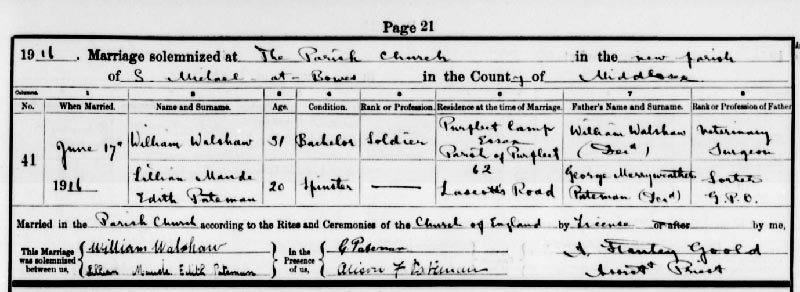
His wife was born in Shoreditch, and living in Tottenham in 1901, recorded as Lillie Pateman in the census. Lillian’s parents had married at St James the Great, Bethnal Green, later chosen for his own marriage by a certain Reggie Kray.

William was reduced to the ranks by court martial on 22 August 1916, evidently for desertion, as he was recorded as a deserter in the Police Gazette of 1 August 1916 with his stated occupation of tailor reflecting his industrial school training. He was awarded six months detention, keeping him out of harm’s way until 21 February 1917. In the meantime he received a new service number of 201803.
The Middlesex Regiment transferred him to the Labour Corps on 25 September 1917, from which he was once more declared a deserter on 8 December 1917, being arrested in January 1918 and again subject to a court martial and a further 18 months detention.

This would seem at first glance to have effectively ended his Great War service, but a further communication refers to his transfer from the Labour Corps to the Manchester Regiment on 2 June 1918. He evidently returned to France with the B.E.F. on this date, and was discharged from the 3rd Battalion Manchester Regiment, as no longer fit for duty, on 11 October 1918, with disability given as a gunshot wound to the right forearm, received on 27 July 1918, and was awarded the Silver War Badge.
His next of kin on discharge was listed as Ruth Fallon of 261A, 5th Avenue, Baltimore, so again he seems not to have received any family support from his home country. His sister Ruth Mary Walshaw had married John Thomas Fallon in Oldham in 1901, emigrated in 1905, and remained in the States until her death in 1951.
She did return for a visit in 1924, and although passenger manifest records her stay was with her married sister Edith in Oldham, it’s not known whether she saw William during her visit.
Sadly, William forfeited his medals because of his record of desertion, as revealed by his medal index card and the medal roll for the Kings Liverpool Regiment, which he joined in 1919.
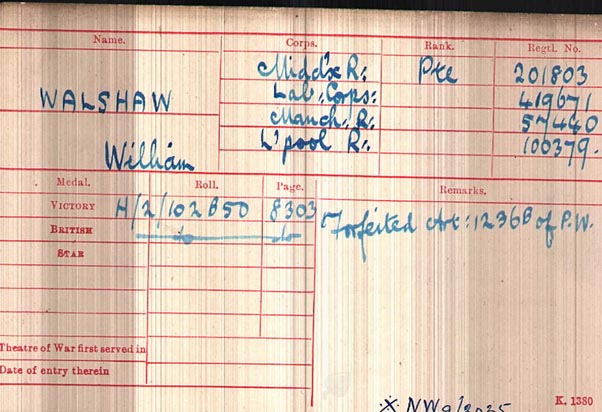

He and his brothers certainly contributed more than fair share to the war effort, with Frederick serving in the Royal Navy, Thomas in the Hussars, and James in the Manchester Regiment.
Post War Military Service
Not to be kept out of the army, William had enlisted as 100379 in the King’s Liverpool Regiment on 12 June 1919. His previous service, with various units, is recorded on his attestation form, but rather strangely he is also credited with his brother’s Boer War service as 5088 Manchester Regiment. (It was noted previously that his brother, James’ record was mixed up with William’s service in the Middlesex Regiment).
His brother, James Burnley Walshaw, had in fact re-enlisted in the Great War as Pte 2504, in the 11th Manchester Regiment and sadly died of wounds at Gallipoli on 4 November 1915.
There may have been a deliberate attempt by William to mislead the army authorities as to prior service, as he claimed to be 39 on his attestation form from 1919, whereas he was only 23.

William was posted to France with the King’s Liverpool Regiment and once again appeared to be prospering, reaching the rank of acting sergeant, until the inevitable desertion on 2 April 1920.
Bigamy and Horse Theft – First Offences
Following his return there were also yet more civil offences, which would surely end his military career, including bigamy and stealing a horse. These were much more serious than William’s earlier offences.


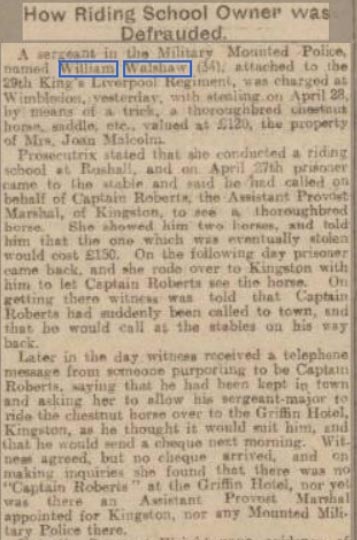
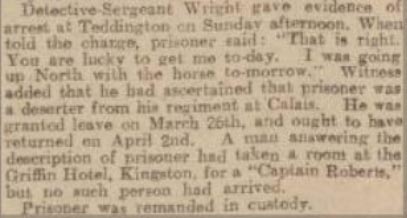
The marriage to Hannah V. Johnson was registered in the West Derby District of Liverpool in the first quarter of 1920 and took place at West Derby Register Office. William married under the alias of William A.G. Walshaw.
Hannah’s birth was registered in West Derby in the fourth quarter of 1897. In 1911 she was living in the Litherland area of Liverpool, her father was a marine fireman. It can be imagined that William didn’t dare return to Liverpool after coming out of prison
The bigamy case tends to explain why William and Lillian only had one child, Ralph Douglas Walshaw, born on 27 October 1916, as William tended to be absent for most of their married life, either in custody or playing away. Not surprisingly William was discharged from the King’s Liverpool Regiment on 4 August 1920 as a result of convictions for the civil offences of felony and bigamy.
Back in the Army
Quite incredibly, our man managed to enlist in the 7 th Manchester Regiment on 10 April 1921, with service number 103. Naturally enough he had once more been declared to have deserted on 14 May, despite being made acting sergeant, and he was once more discharged on this date, having again been convicted of a civil felony.
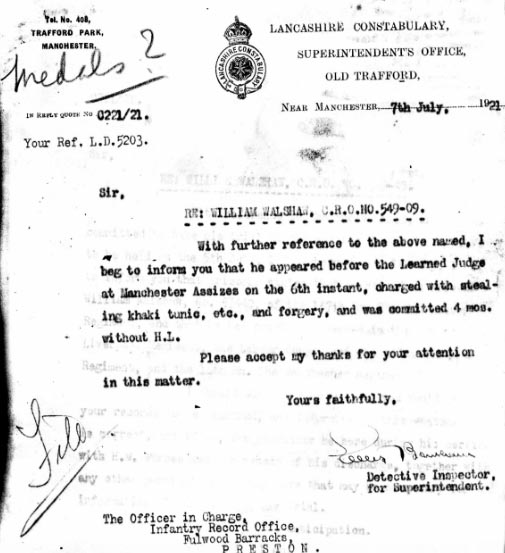
His discharge certificate indicates he had no fixed address. This perhaps wasn’t the end of William’s military career, maybe he later served in the Artillery and the Dragoons under the aliases on his pension card, but surely there had to be time and opportunity to steal another horse and to commit further bigamy.
Bigamy and Horse Theft – the Second Offences
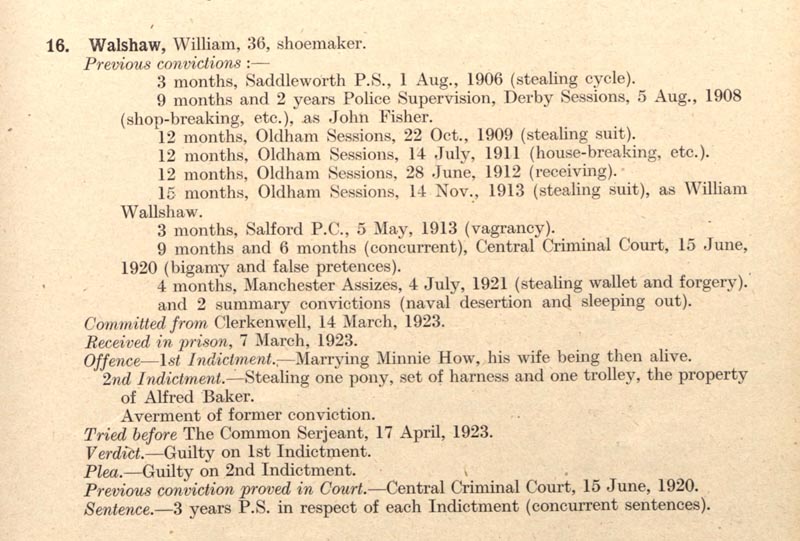

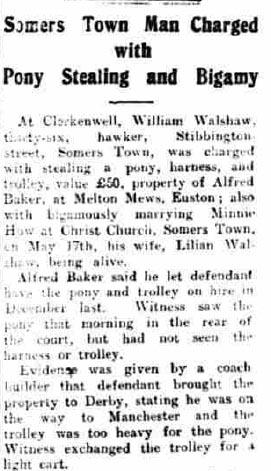

It is no surprise that his real wife felt deserted, his absences reflecting his time spent at His Majesty’s Pleasure.
The register entry for William’s marriage to Minnie How, a piano maker’s daughter, who was living in Tottenham at the time of the 1911 census indicates that William had again made used of the alias he seemingly reserved for bigamous marriages, the marriage register showing him to be William Alfred Gordon Walshaw. Once again, his occupation had reverted to that of tailor, and his late father had once more been elevated to a veterinary surgeon.
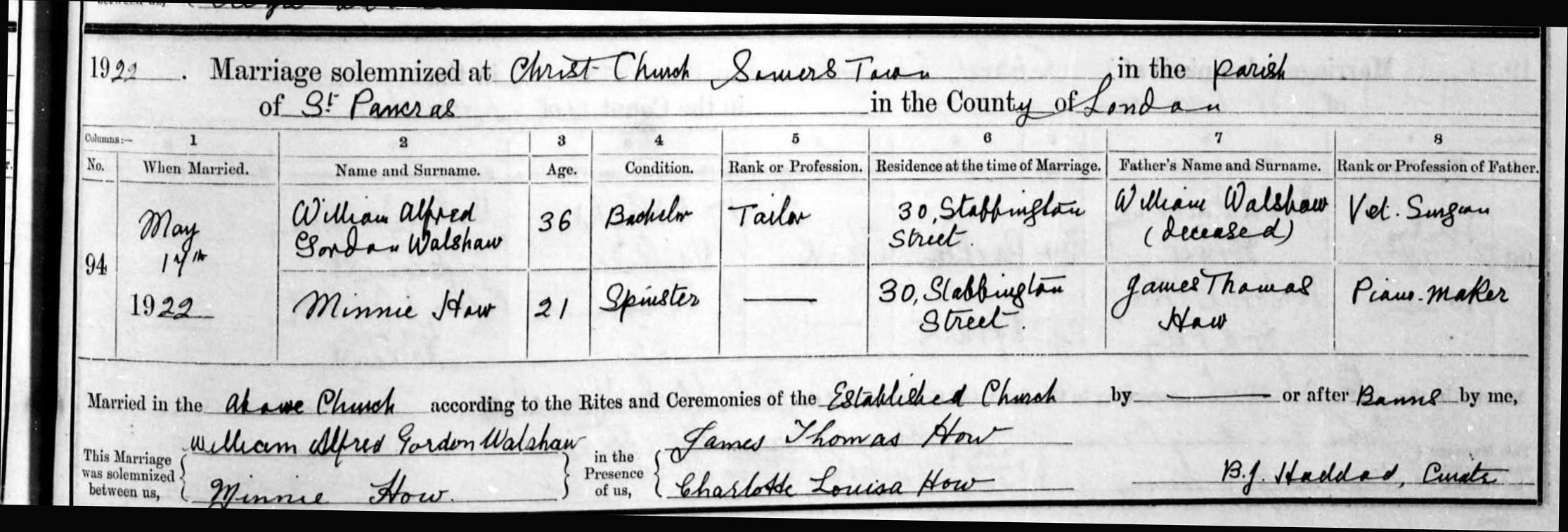

Once More on the Loose
Following his discharge in 1925, William had been promoted by the police to the rank of ‘Expert Criminal’, and The Police Gazette circulated a warning that he was now free to commit further crimes.


His impressive list of aliases is shown, including his favourite alias for use when marrying bigamously. The two aliases on his pension cards, of Alfred Gordon and John Thompson, do not even figure in this list.
Item (i) under ‘method’ relates to the pony and trap, his second horse theft. Item (ii) corresponds to the previously seen document from 7 July 1921, found in his army file. Item (iii) from the above report seemed at first glance to suggest he had actually stolen yet another horse, but almost certainly relates to his first theft of a horse, back in 1920, while impersonating an army captain, rather than to a third horse theft.
William had now moved on to Brighton, and was identified by his new ‘service’ (Case) number of 333 in the Police Gazette of 1928. He was active again in 1929 in the nearby district of Hove and 1930 showed another offence at nearby Portslade.
The 1939 Register records our man to be ‘widowed’ and living in a flat in Brighton. Unfortunately the record is particularly difficult to read, but his date of birth of 13 May 1886 matches both his Royal Navy service records. He was living with an Ella Stanley, and a Patrick Charles Stanley, born in 1932, plus another child whose identity is not disclosed. William seems to have reverted to shoemaker, an occupation recorded on some of his entries found in the Police Gazette. Ella M Green had married Thomas P Stanley in Hammersmith district in 1930, and Patrick Charles Green’s birth was registered in Lambeth in the second quarter of 1932. Little else is known about them.
It hasn’t been possible to establish what happened to his bigamous ‘wives’, Hannah Victoria Johnson and Minnie Hoy, who would have been expected to revert to their original names, rather than be associated with the surname Walshaw. No record could be found of divorce proceedings from his wife Lillian, and it would appear that she set up house with Alfred Charles Gabriel, with whom she had a child Alfred Dennis Gabriel in late 1921. The family were living in East Barnet in 1939, and her death was recorded as Lillian Maud Gabriel in 1980.
Last Recorded Offence
It may be possible to place William in the London area in 1949, as the Marylebone Mercury of 2 September 1949 seems to have recorded his activities. His address in the 1949 Electoral Roll was given as 79 Lancefield Street, and he was the only Walshaw of eight registered occupants.
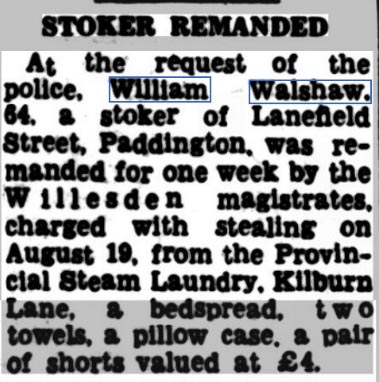
Conclusion and Summary
Although it hasn’t been possible to determine for certain where and when William’s life ended, his death was probably that registered aged 74, in the Bromley district, in late 1959.
Even his son Ralph Douglas Walshaw proved to be something of an enigma, marrying in 1949, in the Surrey NE district to a lady with multiple entries in the marriage register, being listed as Doris Gabriel, Doris Alford, Doris Lack and Doris Walshaw, strongly suggesting that she had been married several times previously. There is absolutely nothing to suggest that Ralph followed in his father’s footsteps, and it is doubtful that their lives ever crossed.
The highlighting of the initial pension card led to more pension cards, several service records, one intermingled with those of a brother, multiple desertions, two bigamous marriages and a prolific list of civil convictions, including the theft of two horses.
William Walshaw’s life was undoubtedly influenced by his difficult early life experiences, particularly the loss of his parents at an early age. He had clearly set out to be a musician in the services, probably influenced by his elder brother and his experience gained at the industrial school. He subsequently made a more than competent soldier, was ever keen to serve in the forces, but unfortunately fell into a life of crime. It would be wonderful to be able to go back in time and help him settle to life in the Royal Marines Band.
For those interested in servicemen who deserted in Great Britain, the recently published book ‘Deserters of the First World War – The Home Front’ by Andrea Hetherington, comes highly recommended and helped to inspire the research for this article.
Article contributed by Dr Alan Hawkins
Editor's note: Interested readers are directed to the WFA's YouTube channel, where you can view Scamps in Khaki: The criminal lives of home front deserters in WW1, a lecture given by Andrea Hetherington at the WFA's 2022 Conference.





